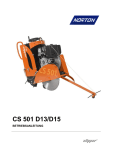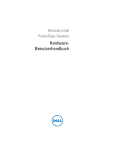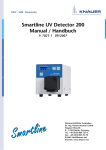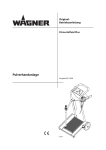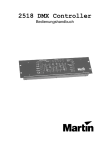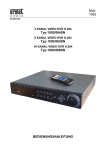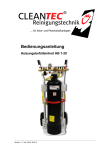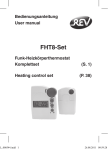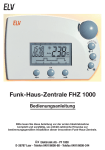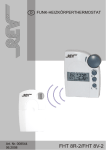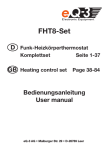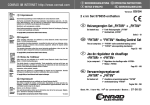Download Smartline Ventilantriebe
Transcript
Smartline Valve Drives S6, S12, S16 Manual / Handbuch V7447-1 09/2007 Wissenschaftliche Gerätebau Dr. Ing. Herbert Knauer GmbH Hegauer Weg 38 D - 14163 Berlin, Germany Tel.: +49 (0)30 809 727 0 Fax.: +49 (0)30 801 50 10 E-Mail: [email protected] Internet: www.knauer.net 3 CONTENTS Using this Manual .................................................................................................4 Conventions in this manual...........................................................................4 SOP´s in this manual ....................................................................................4 General Description..............................................................................................5 Preparing the Electric Valve Drives S 6/-12/-16 for Operation.............................5 Standard Delivery List ....................................................................... 5 Front view of the Valve Drives S 6/-12/-16.....................................................6 Rear view of the Valve Drives S 6/-12/-16 .....................................................7 Operating the Valve Drive S 6/-12/-16 .................................................................8 Power supply ................................................................................................8 Mounting the valve........................................................................................8 Configuring the Smartline Electric Valve Drive.............................................8 6-Port-Multi Channel Valve Switch Positions : ................................ 10 Controlling the Valve Drives S 6 /-12 /-16 ..........................................................11 Manual control ............................................................................................11 External Control of the Valve Drives S 6/-12/-16........................................11 Assembling a remote control cable.............................................................14 Valve drives S 6/12/16 as parts of the Smartline Assistant 6000..........................14 Troubleshooting ..................................................................................................16 Spare parts and accessories ..............................................................................16 Maintenance by the user ....................................................................................16 Declaration of conformity....................................................................................30 Guarantee statement..........................................................................................31 INHALT Zur Benutzung des Handbuches ........................................................................17 Konventionen in diesem Handbuch ............................................................17 SOP´s in diesem Handbuch .......................................................................17 Allgemeine Beschreibung...................................................................................18 Inbetriebnahme des Ventilantriebs S 6/-12/-16 ..................................................18 Lieferumfang.................................................................................... 18 Vorderseite des elektrischen Ventilantriebs S 6/-12/-16...............................19 Rückseite des elektrischen Ventilantriebs S 6/-12/-16 ...............................20 Bedienung des Ventilantriebs S 6/-12/-16..........................................................21 Netzanschluss.............................................................................................21 Montage des Ventils ...................................................................................21 Konfigurierung des elektrischen Ventilantriebs ..........................................21 Schaltstellungen der 6-Port-Mehrkanalventile................................. 23 Steuerung der Ventilantriebe S 6/-12/-16...........................................................24 Manuelle Ansteuerung ................................................................................24 Externe Steuerung der Ventilantriebe S 6/-12/-16......................................24 Konfektionierung der Fernsteuerkabel........................................................27 Einbindung der Antriebe in den Smartline Assistant 6000 .................................27 Wartung durch den Anwender............................................................................29 Troubleshooting ..................................................................................................29 Ersatzteile und Zubehör .....................................................................................29 Garantiebedingungen .........................................................................................30 Konformitätserklärung ........................................................................................31 4 Using this Manual Using this Manual This manual refers to the Smartline Electric Valve Drives S 6, S 12, and S 16. It is valid for any combination of the drive S 6 with the 6-port/3-channel-injection valve, 6-port/2-channel-switching valve, 7-port/1-channel- switching valve, the drive S 12 with the 13-port/1-channel- switching valve, and the drive S 16 with the 17-port/1channel- switching valve. Conventions in this manual Important Hints are marked by the marginal hand symbol. Special warnings are indicated by the marginal warning sign and printed in bold letters. The marginal lamp symbol indicates helpful advice’s. SOP´s in this manual The Standard Operating Procedures (SOP) provided with this manual offer a convenient way of structuring complex tasks for operating the Smartline Electric Valve Drive S 6, S 12, or S 16. They include step-by-step instructions assisting the user through all routine tasks during operation. They can be used for documentation purposes: They can be copied, applied, signed, and filed to document the performance of the instrument. It is very important to follow all instructions and SOP’s in this manual in order to operate the instrument and accessories. This ensures proper results and longevity of your equipment. SOP 1 SOP 2 Mounting the valve to the electric valve drive Connecting the plug strips 8 14 General Description 5 General Description The Smartline Electric Valve Drives S 6, S 12, and S 16 are in design and operation for the most part identical. They are devised for automatic control of the 6-port/3-channel-injection valve, 6-port/2-channel-switching valve, 7-port/1channel-switching valve by S 6 drive, the 13-port/1-channel-switching valve by S 12 drive, and the 17-port/1-channel-switching valve by S 16 drive respectively. The valve drive has to be adapted to the used valve by means of a set of DIP switches at the bottom of the drive housing. All KNAUER valve drives can be integrated into the Smartline Assistant 6000. Valves with 2 positions The 6-port/3-channel-injection valve and the 6-port/2-channel-switching valve can be switched between the LOAD and INJECT position. Switching the positions can be done with a 60° turn forwards or backwards. Valves with 6 positions The 7-port/1-channel-switching valve can be switched to 6 positions. Each switch command will result in a 60° turn, so that the 6th switch command returns to the first position. Valves with 12 positions The 13-port/1-channel-switching valve can be switched to 12 positions. Each switch command will result in a 30° turn, so that the 12th switch command returns to the first position. Valves with 16 positions The 17-port/1-channel-switching valve can be switched to 16 positions. Each switch command will result in a 22.5° turn, so that the 16th switch command returns to the first position. Using remote or software control valves with more than two positions can be switched to any one directly. Preparing the Electric Valve Drives S 6/-12/-16 for Operation Unpacking After unpacking, please check the device and accessories thoroughly for any damage that may have occurred during transportation. If necessary, contact the carrier to claim any damages. Use the “Standard delivery list“ to check if the electric valve drive is complete. Please contact our service department if anything is missing or if you need support. It is important to fill out the guarantee card and return it to us as soon as possible. Please remove the protection foil from the display! Standard Delivery List 1 1 1 1 1 Set 1 1 1,5 m 1 Smartline Electric Valve Drives S 6, S 12, or S 16 Power supply unit 24V/50W Power supply cable, 230V Adapting plate 70x50 Al Tools RS-232 cable WAGO Terminal Strip Set signal conductors User Manual 6 Preparing the Electric Valve Drives S 6/-12/-16 for Operation Front view of the Valve Drives S 6/-12/-16 1 2.1 2.2 3 4 5 Fig. 1 Front view of the Electric Valve Drive S 16 with 17port/1channel-switching valve 1 2 2.1 2.2 3 4 5 Display Foil keys LOAD position, or increasing the position number INJECT position, or decreasing the position number Valve (7port/1channel) Adapter plate Mounting screw 6 2 5 3 4 Fig. 2 Schematic front view of the 7-port/1-channel-switching valve 1 6 2 5 3 4 Fig. 3 Schematic front view of the 6-port/2-channel-switching valve and the 6-port/3channel-injection valve The actual position is shown with one or two digits on the LED display (1). For valve drives with two positions L for LOAD and I for die INJECT will be displayed. Preparing the Electric Valve Drives S 6/-12/-16 for Operation 7 Rear view of the Valve Drives S 6/-12/-16 1 RS-232 connector 2 Remote control strip 4 Power supply 5 Serial number Fig. 4 Rear view of the valve drives S 6/-12/-16 Except for the power socket 4 and an additional ground connector 3, the serial RS-232 interface 1 for external computer control and the remote control inputs and outputs 2 can be seen here. Table 1 Terminal connections GROUND: Ground connector HOME: Sets the valve drive to position 1 FORWARD / LOAD: Sets the valve drive to the LOAD position or the next higher position i.e. 2→3 BACKWARD / INJECT: Sets the valve drive to the INJECT position or the next higher position i.e. 3→2 OUT: Control output in position 1 has a lowresistance in the INJECT or in position 1 and has a high resistance in the LOAD or in positions 2-6 (2-16) Depending on the DIP positions the four connectors BIN 0 to BIN 3 can be used alternatively for binary event control. 8 Operating the Valve Drive S 6/-12/-16 Operating the Valve Drive S 6/-12/-16 Power supply The valve drive is equipped with a universal power supply unit which operates in a range of 90 to 260 Volts AC. A manual setting of the supply voltage is, therefore, not required. Make sure that the main power supply is properly grounded and the correct power cable is used. The power supply for the drive is not included in the housing. Please connect the power supply to the drive (item 4 in Abb. 4). Then connect the power cable to the power supply and the socket. If required connect the ground connector 3 to the corresponding ground contact of any other grounded instrument. Wait for at least 30 seconds before restarting the drive after switching it off. Otherwise an error message will be displayed. Mounting the valve The Smartline Electric Valve Drives S 6/-12/-16 have to be used in combination with one of the KNAUER-valves. For instructions on how to operate the valves refer to the corresponding valve manuals. SOP 1 Mounting the valve to the electric valve drive 1. 2. 3. 4. Fix the adapter plate with the two M4 screws at the rear side of the valve. Set the drive on position 1 respectively LOAD. Push the valve on the driving axle on the front side of the instrument. Take care that the mark on the valve matches this one above the wheel. The valve position 1 must be on top. 5. Fix the valve and adapter plate with the two mounting screws. If the position was not set on LOAD or 1, you will get the error message E 4 when starting the drive. Configuring the Smartline Electric Valve Drive At the bottom of the instrument the DIP-switches 1-4 (Abb. 5) are arranged. They are needed to adapt the drive to the actual mounted valve. ON 1 Fig. 5 2 3 4 DIP-switches 1-4 at the drive bottom DIP 1 adapts the two position or multi-position valve (S 6). The valve drive S 12, exclusively used to control the 13-port/1-channel switching valve, can only be operated with the DIP 1 switch in the ON position! Operating the Valve Drive S 6/-12/-16 9 The valve drive S 16, exclusively used to control the 17-port/1-channel switching valve, can only be operated with the DIP 1 switch in the OFF position! Using DIP 2 the control mode is set to either FORWARD/ BACKWARD/HOME or to the absolute position input. This will simultaneously activate the inputs BIN 0 through BIN 2. The connector OUT/BIN3 can be used either as output or as input. The selection is performed by setting DIP 3 and DIP 4. The DIP-switches 3 and 4 always should be set in opposite positions. Not all of the possible combinations of DIP positions are permitted when operating the valve drive. If an improper DIP setting is used, an error message will appear either when switching the drive on or when the valve is switched. The DIP setting always has to be done with the drive switched off. Otherwise the DIP positions will not become active. Table 2 DIP-switch positions in valve drive S 6 DIP 1 DIP 2 ON 360° valve (7-p/1-ch) OFF Two position valves (6-p/2-ch and 6-p/3-ch) ON binary control BIN 0-2 (360° valves only) OFF RS-232 control/ manually/ HOME/ INJ./ LOAD DIP 3 DIP 4 ON OFF OUT/ BIN 3 output DIP 3 DIP 4 OFF ON not allowed Table 3 DIP-switch positions in valve drive S 12 DIP 1 DIP 2 ON 360° valve (13-p/1-ch) OFF not allowed ON binary control BIN 0-2 OFF RS-232 control/ manually/ HOME/ INJ./ LOAD DIP 3 DIP 4 ON OFF OUT/ BIN 3 output DIP 3 DIP 4 OFF ON OUT/ BIN 3 input 10 Operating the Valve Drive S 6/-12/-16 Table 4 DIP-switch positions in valve drive S 16 DIP 1 DIP 2 DIP 3 DIP 4 ON not allowed OFF 360° valve (17-p/1-ch) ON binary control BIN 0-2 OFF RS-232 control/ manually/ HOME/ INJ./ LOAD ON OFF OUT/ BIN 3 output DIP 3 OFF OUT/ BIN 3 input DIP 4 ON The data in the above tables imply that only one or two DIP combinations are possible for any of the valves to be controlled. Table 5 Allowed DIP combinations Valve Mode 6-port/2-channel 6-port/3-channel analog OFF OFF ON OFF analog ON OFF ON OFF binary ON ON ON ON OFF OFF ON OFF 7-port/1-channel 13-port/1-channel 17-port/1-channel DIP position analog binary Drive analog ON ON OFF ON OFF OFF ON OFF binary OFF ON OFF ON 1 3 DIP switch No : 2 S6 S 12 S 16 4 6-Port-Multi Channel Valve Switch Positions : The internal port connections of the multi-channel valves are shown in the following table. Table 6 Port connections in multi-channel valves (INJECT) Operated Key Display (LOAD) I L 1 1 Connected ports 6 2 6 2-Channel valve 5 3 5 1 6 3-Channel valve 5 4 3 4 4 Connected ports 2 1 2 6 3 5 2 3 4 Controlling the Valve Drives S 6 /-12 /-16 11 Controlling the Valve Drives S 6 /-12 /-16 Manual control In order to operate the electrical valve drives S 6/-12/-16 manually, the DIP 2 must be in the OFF position. 2 position valves The positions LOAD and INJECT can be set by directly using the keys. und In the manual mode it is still possible to integrate the valve drive into a more complex chromatographic system. By switching the valve to the INJECT position, the OUT connector is short circuited. This signal can start time dependent gradient programs. The OUT connector is only active when the valve is in the INJECT position. To avoid unintentionally restarting the program, turn the valve back to the LOAD position before the current program is completed. 6 , 12, and 16 position valves Any valve position can be achieved in an increasing order by pushing the key as often as necessary. The steps 6→1, 12→1, or 16→1 are also considered an increasing order. The opposite steps: 1→6, 1→12, or 1→16 are considered a decreasing order. To decrease a step press the key. Similar to the two position valves, the OUT connector can be used to control other instruments. The output is only active if the valve is in the HOME position (position 1). It is inactive if the valve is in positions 2 to 6, 2 to 12, or 2 to 16. External Control of the Valve Drives S 6/-12/-16 The valve drive S 6/-12/-16 can be controlled with external contacts and can also send signals to other instruments. Communication is possible via the RS-232 interface or using the additional remote control connector (Pos 2 in Fig. 4). If more than one valve drives are integrated into the system they should be controlled in the same control mode (RS-232 or WAGO). Specifically, if a coupled-columns technique is required. Control via RS-232 interface To control any valve via the RS-232 interface the drive has to be set to the analog mode (DIP switch 2 OFF). The valve drives can be integrated into HPLC systems which are controlled with software packages such as ChromGate® or EuroChrom® . Instructions can be found in the corresponding software manuals. The control via the serial RS-232 interface at the rear of the instrument, item 1 in Abb. 4 on page 20, also can be performed with small selfdesigned programs which can be integrated into non-Knauer software products. The specifications for data transfer are: 9600 baud 8 bit 1 start-bit 1 stop-bit 12 Controlling the Valve Drives S 6 /-12 /-16 The possible commands are listed in the following table. Any command must be confirmed using ↵ (=<ENTER>). Table 7 Table of commands Command Action Remark 1,2,3,...,6 (...,15,16,01,...) Valve moves to the entered position H,h Valve moves to the HOME position (1) 360°-Valves only L,l Valve moves to the LOAD position L/I -Valves only I,i Valve moves to the INJECT position L/I -Valves only V,v Program version inquiry P,p Actual position inquiry T,t Actual valve type inquiry 360°-Valves only Short circuit signals from the OUT connector can be used besides the RS-232 control to control other instruments. The output is active or inactive under the same conditions as described for the manual control. If the additional inputs HOME, INJ., and/or LOAD are in use, the RS-232 connections have priority. Remote control via Events Generally the connections on the remote control strip are layed out as open collector (OC). Therefore the right polarity of any connection has to be obeyed. 2 position valves Using this valve, the HOME input is inactive. If the LOAD input is short circuited to the GROUND, only the INJ. and GROUND have to be connected to the signal sending instrument (i.e. the interface box). If no signal is sent to the INJ., the valve will be in the LOAD position due to the LOAD GROUND short circuit. If INJ. is short circuited as well, the valve will switch to the INJECT position. INJ. has a higher priority than the LOAD. 6, 12, and 16 position valves The 360° valves only can be operated either in an analog or in a binary mode. For the corresponding DIP positions refer to table 4 on page 10. Controlling in analog mode Short circuit signals from the OUT connector can be used to control other instruments. The output is only active if the valve is in the HOME position (1). It is inactive with the valve in positions 2 to 6, 2 to 12, and 2 to 16. Three input connectors are available. A short circuit signal to HOME moves the valve to position 1. Similar signals to BACKW./INJ. and FORW./LOAD will move the valve back or forward one position. To switch the valve twice in the same direction the short circuit has to be shortly interrupted like a pulse circuit. The most frequently used connector for the remote control strip is the Knauer interface box IF2. This wiring is illustrated in Fig. 6. If the drive control takes place via a pump, refer to the corresponding pump manual for the wiring. Controlling the Valve Drives S 6 /-12 /-16 13 interface box IF2 Fig. 6 valve drive Wiring the valve drive to the interface box IF2 Controlling in the binary mode Switching the control into the binary mode will activate the inputs BIN 0 through BIN 2. The output OUT is active in positions 1 through 6, however it is inactive in the process of switching. This activity change can be used as an outgoing signal to control other instruments. To operate the 17-port/1-channel valve, BIN 3, also defined as an input, is connected so that positions 9 through 16 can also be binary controlled. When operating this valve, an output signal cannot be sent. Every position now is binary defined as shown in the following table. Table 8 Binary defined positions Pos. 1 2 3 4 5 6 7 8 9 10 11 12 13 14 15 16 BIN 0 BIN 1 BIN 2 BIN 3 (23=8) binary result 0 1 0 1 0 1 0 1 0 1 0 1 0 1 0 1 0 0 1 1 0 0 1 1 0 0 1 1 0 0 1 1 0 0 0 0 1 1 1 1 0 0 0 0 1 1 1 1 0 0 0 0 0 0 0 0 1 1 1 1 1 1 1 1 0 1 2 3 4 5 6 7 8 9 10 11 12 13 14 15 (20=1) (21=2) (22=4) 14 Valve drives S 6/12/16 as parts of the Smartline Assistant 6000 Assembling a remote control cable If the remote control is performed not using the RS-232 interface a different type of control cable must be assembled for each application. Use the set plug strips with connectors enclosed in the delivery to prepare your cable according the following SOP. SOP 2 Connecting the plug strips Use this SOP for connecting wires to the plug strips. 1. Press down the cable clip as shown in Fehler! Verweisquelle konnte nicht gefunden werden. using a small srew driver or the WAGO liner tool. 2. Insert the uninsulated end of the cable into the opening under the latch. 3. Remove the tool from the plug. The cable is now firmly anchored in the plug strip. Fig. 7 Connecting the Plug Strips Valve drives S 6/12/16 as parts of the Smartline Assistant 6000 The valve drives S 6/12/16 as well as the UV-Detector 200 and/or the Pump S 100 can be an integrative part of the Smartline Assistant 6000. Up to three of these instruments can be placed in one Smartline housing. Thus, even a whole HPLC system can be put into one modul. 1 Fig. 8 2 3 Front view of the Smartline Assistant 6000 (A5003V065), with: 1 UV Detector 200, 2 Smartline Pump 100 and 3 injection valve (manual) Valve drives S 6/12/16 as parts of the Smartline Assistant 6000 15 An electrically driven injection valve can be placed in the rear position instead of the fractionation valve as in Fig. 9. The preparative Modul 6100 is another example. It is equipped with a Smartline Pump 100 and zwei two valve drives. The pump and the front valve are forming the injection system. The second valve drive in the rear is for fractionation and solvent recycling. 2 1 3 Fig. 9 Frontview of the Prepmodule 6100 1 Smartline Pump 100 2 Injection valve and 3 Fractionation valve The GPC Sample Preparation Unit 6500 is another example. It consists of a Smartline Pump 1000 and two versions of the Smartline Assistant 6000. Five valves and one UV Detector 200 are integrated into the Assitant versions V416 and V044. 1 Fig. 10 Front view of the GPC Cleanup Unit 6500 The control connectors of all three instruments are on the rear side of the modul. The DIP switches for configuring the valve drive are according to the single instruments at the bottom. 16 Troubleshooting Troubleshooting Error messages will be displayed in the form of „En“ (n = error code). A question mark “?” will appear if an invalid command is entered. Table 9 List of error codes, causes, and solutions code probable cause solution E0 valve has not switched exchange valve sealing E1 motor power consumption to high exchange valve sealing E2 position changing to slow exchange valve sealing E3 DIP 3 and 4 in wrong setting correct the settings E4 position 1 no longer corresponds exchange valve sealing to HOME E5 DIP 1 and 2 in wrong setting correct the settings wrong binary code correct the settings error while reading the EEPROM restart the instrument E6 In case the purposed solutions will not solve your problems, please contact our service department. Spare parts and accessories Power supply cable, 230V M1642 RS-232 cable A0895 Set WAGO connecting rails A1402 Set signal conductors A1467 Maintenance by the user The Electric Valve Drives S 6, S 12, and S 16 do not need any maintenance. In case of problems please contact our service department. Zur Benutzung des Handbuches 17 Zur Benutzung des Handbuches Dieses Handbuch bezieht sich auf die elektrischen Ventilantriebe S 6, S 12 und S 16. Es gilt für alle Kombinationen des Antriebs S 6 mit dem 6-Port/3-Kanal-Injektionsventil, dem 6-Port/2-Kanal-Schaltventil, dem 7-Port/1-Kanal-Schaltventil bzw. des Antriebs S 12 mit dem 13-Port/1-Kanal-Schaltventil und des Antriebs S 16 mit dem 17-Port/1-Kanal-Schaltventil. Konventionen in diesem Handbuch Wichtige Hinweise werden in der Marginalspalte durch das Hinweissymbol kenntlich gemacht. Besondere Warnhinweise und Hinweise auf mögliche Probleme sind mit dem Warnsymbol gekennzeichnet. Ein nützlicher Tip wird in der Marginalspalte durch das Symbol hervorgehoben. SOP´s in diesem Handbuch Die Standardarbeitsanweisungen (Standard Operating Procedures, SOP) dieses Handbuches ermöglichen die Strukturierung zusammenhängender Aufgaben beim Betrieb Ihres Ventilantriebs S 6/-12/-16. Sie beinhalten schrittweise Anweisungen, die den Anwender durch alle Aufgaben führen. Sie können gleichfalls zu Dokumentationszwecken genutzt werden. Sie können kopiert, angewendet, unterzeichnet und abgelegt werden, um so die Leistungsfähigkeit Ihres Gerätes zu dokumentieren. Bitte betreiben Sie das Gerät inklusive Zubehör gemäß der SOPs in diesem Handbuch. Andernfalls können fehlerhafte Meßergebnisse, Beschädigungen oder gesundheitliche Beeinträchtigungen des Anwenders eintreten, obwohl dieses Gerät außerordentlich robust und betriebssicher ist. SOP 1 SOP 2 Ventilmontage an den elektrischen Antrieb Montage der Fernsteuerleitung 21 27 18 Allgemeine Beschreibung Allgemeine Beschreibung Die elektrischen Ventilantriebe S 6, S 12 und S 16 sind in Gestaltung und Betrieb weitestgehend identisch. Sie sind für die automatische Ansteuerung des 6-Port/3Kanal-Injektionsventils und der 6-Port/2-Kanal- und 7-Port/1-Kanal-Schaltventile konzipiert (S 6), beziehungsweise für die Ansteuerung des 13-Port/1-KanalSchaltventils (S 12) und des 17-Port/1-Kanal-Schaltventils (S 16). Die gegenseitige Anpassung von Antrieb und Ventil wird durch DIP-Schalterstellungen an der Unterseite des Antriebsgehäuses vorgenommen. Alle KNAUER Ventilantriebe können in den Smartline Assistant 6000 integriert sein. Ventile mit 2 Schaltpositionen Das 6-Port/3-Kanal-Injektionsventil und 6-Port/2-Kanal-Schaltventil werden in 2 Schaltpositionen angesteuert, der LOAD und der INJECT Position. Der Wechsel zwischen den Positionen erfolgt durch Vor- bzw. Rückdrehung um 60°. Ventile mit 6 Schaltpositionen Das 7-Port/1-Kanal-Schaltventil wird in 6 Schaltpositionen angesteuert. Jeder Schalttakt bewirkt eine Drehung um 60°, so dass mit dem 6. aufeinander folgenden Schalttakt wieder die Ausgangsposition erreicht wird. Ventile mit 12 Schaltpositionen Das 13-Port/1-Kanal-Schaltventil wird in 12 Schaltpositionen angesteuert. Jeder Schalttakt bewirkt eine Drehung um 30°, so dass mit dem 12. aufeinander folgenden Schalttakt wieder die Ausgangsposition erreicht wird. Ventile mit 16 Schaltpositionen Das 17-Port/1-Kanal-Schaltventil wird in 16 Schaltpositionen angesteuert. Jeder Schalttakt bewirkt eine Drehung um 22,5°, so dass mit dem 16. aufeinander folgenden Schalttakt wieder die Ausgangsposition erreicht wird. Bei Fern- oder Softwaresteuerung ist für die Ventile mit mehr als zwei Schaltpositionen auch die direkte Positiionsansteuerung möglich. Inbetriebnahme des Ventilantriebs S 6/-12/-16 Alle KNAUER-Geräte werden ab Werk sorgfältig und sicher für den Transport verpackt. Prüfen Sie dennoch nach dem Auspacken alle Geräteteile und das Zubehör auf mögliche Transportschäden und machen Sie gegebenenfalls Schadenersatzansprüche sofort beim Transportunternehmen geltend. Bitte überprüfen Sie das Zubehör auf Vollständigkeit. Entfernen Sie die transparenten Schutzfolie vom Display. Sollte trotz unserer sorgfältigen Ausgangskontrollen ein Teil fehlen, wenden Sie sich bitte an unsere Serviceabteilung. Please remove the protection foil from the display! Lieferumfang 1 bestehend aus: 1 1 1 1 Satz 1 1 1,5 m 1 elektrischer Ventilantrieb S 6, S 12 oder S 16 Netzteil 24V/50W Netzkabel mit Kaltgerätestecker Adapterscheibe 70x50 Al Werkzeug RS-232 Verbindungskabel WAGO Anschlussleiste Flachbandkabel, 10 polig Handbuch Inbetriebnahme des Ventilantriebs S 6/-12/-16 19 Vorderseite des elektrischen Ventilantriebs S 6/-12/-16 1 2.1 2.2 3 4 5 Abb. 1 Vorderansicht des elektrischen Ventilantriebs S 16 mit 7-Port/1-Kanal-Schaltventil 1 2 2.1 2.2 3 4 5 Positionsanzeige Bedientasten LOAD Position bzw. Erhöhung der Positionsnummer INJECT Position bzw. Verminderung der Positionsnummer Ventil Adapterscheibe Imbus-Montageschrauben 6 2 5 3 4 Abb. 2 Schematische Vorderansicht 7-Port/1-Kanal-Schaltventil 1 6 2 5 3 4 Abb. 3 Schematische Vorderansicht Injektionsventil 6-Port/2-Kanal-Schaltventil und 6-Port/3-Kanal- Die Positionsanzeige 1 ist als LED-Display mit 2-ziffriger Anzeige ausgelegt. Beim Verwenden eines Ventils mit zwei Schaltpositionen wird nicht die Positionsnummer, sondern L für die LOAD Position und I für die INJECT Position angezeigt. 20 Inbetriebnahme des Ventilantriebs S 6/-12/-16 Rückseite des elektrischen Ventilantriebs S 6/-12/-16 1 RS-232 Anschluss 2 Fernsteuerungsanschluss 4 Stromversorgungsanschluss 5 Seriennummer Abb. 4 Rückseitenansicht des elektrischen Ventilantriebs S 6/-12/-16 Außer der Stromversorgungsbuchse 4 und einem extra Masseanschluss zur Erdung 3 finden Sie hier die serielle RS-232 Schnittstelle 1 zur externen Computersteuerung des elektrischen Ventilantriebs und die Fernsteuerungseingänge und -ausgänge 2, deren Belegung die nachfolgende Tabelle zeigt. Tabelle 1Belegung der Fernsteuerungsanschlüsse GROUND: Masseanschluss HOME: Setzt den Ventilantrieb auf Position 1 FORWARD / LOAD: Setzt den Ventilantrieb auf die LOAD bzw. nächst höhere Position z.B. 2→3 BACKWARD / INJECT: Setzt den Ventilantrieb auf die INJECT bzw. nächst tiefere Position z.B. 3→2 OUT: Steuerausgang niederohmig in Position 1 bzw. INJECT und hochohmig in den Positionen 2-6 (2-16) bzw. LOAD Alternativ werden die vier Anschlüsse bei entsprechender DIP-Schalterstellung als BIN 0 bis BIN 3 für binäre Eventansteuerungen genutzt. Bedienung des Ventilantriebs S 6/-12/-16 21 Bedienung des Ventilantriebs S 6/-12/-16 Netzanschluss Die elektrischen Ventilantriebe S 6, S 12 und S 16 werden mit einem 24V Gleichstrommotor betrieben. Die Stromversorgung erfolgt über ein zum Lieferumfang gehörendes Netzteil, das für einen Spannungsbereich von 90 bis 240 Volt Wechselstrom ausgestattet ist. Ein manuelles Einstellen der anliegenden Versorgungsspannung ist daher nicht erforderlich. Verbinden Sie das Netzkabel mit dem Netzteil und dessen Niederspannungskabel mit der Buchse 4 auf der Geräterückseite in Abb. 4. Der Erdungsanschluss 3 in der Mitte unten auf der Rückplatte kann bei Bedarf mit einem Erdungskontakt oder mit einem Erdungsanschluss anderer (geerdeter !) Geräte verbunden werden. Warten Sie nach jedem Ausschalten eine halbe Minute vor dem Wiedereinschalten. Es erscheinen sonst Fehlermeldungen. Montage des Ventils Der elektrische Ventilantrieb wird in Kombination mit einem KNAUER-Ventil betrieben. Die Handhabung des jeweiligen Ventils ist der entsprechenden Bedienungsanleitung zu entnehmen. SOP 1 Ventilmontage an den elektrischen Antrieb 1. Schrauben Sie die Adapterscheibe mit den beiden M4-Senkschrauben auf die Ventilrückseite. 2. Stellen Sie den Antrieb auf die Position 1 bzw. LOAD. 3. Stecken Sie das Ventil auf die Antriebsachse des elektrischen Ventilantriebs an der Gerätefrontseite. 4. Beachten Sie dabei, dass die Körnung auf der Ventilrückseite über derjenigen auf der Antriebsachse liegt. Der Ventilport 1 muss nach oben ausgerichtet sein. 5. Befestigen Sie die Adapterscheibe mit den beiden M4-Imbusschrauben am Gehäuse. War bei der Montage des Ventils an den Antrieb nicht Position LOAD bzw. 1 eingestellt, erscheint beim Einschalten des Gerätes die Fehlermeldung – E 4. Konfigurierung des elektrischen Ventilantriebs An der Geräteunterseite befinden sich die DIP-Schalter 1-4 (Abb. 5), mit denen der Antrieb entsprechend dem montierten Ventil und dem beabsichtigten Steuermodus konfiguriert werden muss. ON 1 Abb. 5 2 3 4 DIP-Schalter 1-4 an der Geräteunterseite Mit der Stellung des DIP-Schalters 1 wird bei einem S 6 der zu schaltende Ventiltyp festgelegt, ob es sich um ein 2- oder Mehrstellungsventil handelt. 22 Bedienung des Ventilantriebs S 6/-12/-16 Der Ventilantrieb S 12, mit dem ausschließlich das 13-Port/1-KanalSchaltventil gesteuert wird, darf nur mit DIP-Schalter 1 in ON Stellung betrieben werden! Der Ventilantrieb S 16, mit dem ausschließlich das 17-Port/1-KanalSchaltventil gesteuert wird, darf nur mit DIP-Schalter 1 in OFF Stellung betrieben werden! Mit dem DIP-Schalter 2 wird die Steuerung entweder auf FORWARD/BACKWARD/ HOME eingestellt oder in die „absolute“ Positionsvorgabe, wodurch die Eingänge BIN 0 - 2 aktiviert werden. Die Stellung der DIP-Schalter 3 und 4 entscheidet über die Verwendung des Anschlusses OUT/BIN3 als Ein- oder Ausgang. Die DIP-Schalter 3 und 4 sollen immer entgegengesetzt geschaltet sein. Nicht alle möglichen Kombinationen der DIP-Schalterstellungen sind für den Betrieb erlaubt. Bei unzulässigen Schalterkombinationen kann es entweder beim Einschalten des Gerätes oder beim Schaltversuch zu entsprechenden Fehlermeldungen kommen. Die Konfigurierung muss stets am ausgeschalteten Gerät durchgeführt werden, sonst wird vom Gerät die Neukonfigurierung nicht übernommen. Tabelle 2 DIP-Schalterbelegung im Ventilantrieb S 6 DIP 1 DIP 2 ON 360° Ventil (7-P/1-K) OFF Zweistellungsventil (6-P/2-K und 6-P/3-K) ON binäre Steuerung BIN 0-2 (nur 360° Ventil) OFF RS-232 Steuerung/ manuell/ HOME/ INJ./ LOAD DIP 3 DIP 4 ON OFF OUT/ BIN 3 Ausgang DIP 3 DIP 4 OFF ON nicht erlaubt Tabelle 3 DIP-Schalterbelegung im Ventilantrieb S 12 DIP 1 DIP 2 ON 360° Ventil (13-P/1-K) OFF nicht erlaubt ON binäre Steuerung BIN 0-3 OFF RS-232 Steuerung/ manuell/ HOME/ INJ./ LOAD DIP 3 DIP 4 ON OFF OUT/ BIN 3 Ausgang DIP 3 DIP 4 OFF ON OUT/ BIN 3 Eingang Bedienung des Ventilantriebs S 6/-12/-16 23 Tabelle 4 DIP-Schalterbelegung im Ventilantrieb S 16 DIP 1 DIP 2 ON nicht erlaubt OFF 360° Ventil (17-P/1-K) ON binäre Steuerung BIN 0-3 OFF RS-232 Steuerung/ manuell/ HOME/ INJ./ LOAD DIP 3 DIP 4 ON OFF OUT/ BIN 3 Ausgang DIP 3 DIP 4 OFF ON OUT/ BIN 3 Eingang Aus den Daten der Tabellen leitet sich ab, dass für jedes der mit den elektrischen Ventilantriebe steuerbaren Ventile nur eine oder zwei Möglichkeiten der DIPSchalterstellungen in Frage kommen. Tabelle 5 Erlaubte DIP-Schalterkombinationen Ventil Modus DIP-Stellungen 6-Port/2-Kanal 6-Port/3-Kanal analog OFF OFF ON OFF 7-Port/1-Kanal analog binär ON ON OFF ON OFF ON ON OFF S6 13-Port/1-Kanal analog binär ON ON OFF ON OFF ON OFF ON S 12 17-Port/1-Kanal analog binär OFF OFF ON OFF OFF ON OFF ON S 16 1 DIP-Schalter Nr. : 2 Antrieb 3 4 Schaltstellungen der 6-Port-Mehrkanalventile Das 6-Port/2-Kanal- und das 6-Port/3-Kanal-Ventil sind antriebstechnisch identisch. Sie unterscheiden sich voneinander ausschließlich durch ihre internen Portverbindungen. Diese sind in der folgenden Tabelle dargestellt. Weitere Details siehe Ventilemanual. Tabelle 6 Portverbindungen in Mehrkanalventilen Betätigte Taste (INJECT) Display (LOAD) I L 1 1 Verbundene Ports 6 im 2-Kanalventil 5 2 6 3 5 1 Verbundene Ports im 3-Kanalventil 5 4 3 4 4 6 2 1 2 6 3 5 2 3 4 24 Steuerung der Ventilantriebe S 6/-12/-16 Steuerung der Ventilantriebe S 6/-12/-16 Manuelle Ansteuerung Für den manuellen Betrieb muss unabhängig vom angesteuerten Ventiltyp der analog-Modus eingestellt sein (DIP-Schalter 2 in OFF). Ventile mit 2 Schaltpositionen Die Positionen LOAD und INJECT können direkt über die Tasten eingestellt werden. und Auch beim manuellen Betrieb ist die Integration des Ventilantriebs in ein komplexes chromatographisches System möglich. Über den Ausgang OUT, der nur in der INJECT-Stellung aktiv ist, kann durch das Umschalten auf INJECT gleichzeitig ein Kurzschlusssignal an andere Geräte übermittelt werden, mit dem z.B. ein zeitabhängiges Gradientenprogramm gestartet wird. Um einen unbeabsichtigten Neustart zu vermeiden, sollte das Ventil vor Beendigung des laufenden Programms wieder zurück in die LOAD Position geschaltet werden. 360° Ventile mit 6, 12 oder 16 Schaltpositionen Die einzelnen Positionen können durch Drücken der Taste der Taste in aufsteigender und in abnehmender Folge erreicht werden. Die Wechsel 6→1, 12→1 beziehungsweise 16→1 sind ebenfalls aufsteigend, wie umgekehrt die direkten Wechsel 1→6, 1→12 beziehungsweise 1→16 absteigend sind. Auch bei diesen Ventilen können über den OUT Ausgang Kurzschlusssignale zur Steuerung an andere Geräte gesendet werden. Der Ausgang ist jeweils aktiv, wenn sich das Ventil in der HOME Position (=Position 1) befindet. In den Positionen 2-6, 2-12 bzw. 2-16 ist der Ausgang inaktiv. Externe Steuerung der Ventilantriebe S 6/-12/-16 Die elektrischen Smartline Ventilantriebe S 6/-12/-16 können sowohl durch externe Kontakte gesteuert werden, als auch Signale an andere Geräte senden. Die Kommunikation ist grundsätzlich sowohl über die RS-232 Schnittstelle, als auch über den zusätzlichen Fernsteuerungsanschluss (Position 2 in Abb. 4) möglich. Sind mehr als ein Ventilantrieb in das System integriert, sollten diese im gleichen Steuermodus (RS-232 oder WAGO) betrieben werden. Das gilt insbesondere für zeitgleiches Schalten in Säulenschaltungen. Steuerung über die RS-232 Schnittstelle Für die Steuerung über die RS-232 Schnittstelle muss unabhängig vom angesteuerten Ventiltyp der analog-Modus eingestellt sein (DIP-Schalter 2 in OFF). Die Steuerung des Ventilantriebs kann über die serielle RS-232 Schnittstelle an der Geräterückseite durch KNAUER HPLC Softwarepakete erfolgen. Über die Einbindung des elektrischen Ventilantriebs S 6/-12/-16 in Ihr durch Software gesteuertes System informieren Sie sich bitte im Handbuch für das zutreffende Softwarepaket. Die Steuerung der Ventilantriebe S 6/-12/-16 kann auch selbst programmiert und in knauerfremde Softwareprodukte eingebunden werden. Die hierfür gültigen Befehle sind in der Tabelle 7 aufgeführt. Jeder Befehl muss mit ↵ (=<ENTER>) abgeschlossen werden. Steuerung der Ventilantriebe S 6/-12/-16 25 Für die Einstellungen der Schnittstelle gilt: 9600 baud 8 bit 1 start bit 1 stop-bit Tabelle 7 Tabelle der Kommandos Kommando Aktion 1,2,3,...,6 Ventil fährt in die eingegebene Position (..,15,16,01,..) Bemerkung nur 360°-Ventile H,h Ventil fährt in die HOME-Position (Pos.1) L,l Ventil fährt in die LOAD-Position nur L/I-Ventile I,i Ventil fährt in die INJECT-Position nur L/I-Ventile V,v Ausgabe der Programmversion P,p Ausgabe der aktuellen Position T,t Ausgabe des Ventiltyps nur 360°-Ventil Parallel zur Steuerung über die RS-232 Schnittstelle kann der Anschluss OUT der WAGO Anschlussleiste zur Schaltung anderer Geräte genutzt werden. Bezüglich der Aktivierung des Ausganges gelten die gleichen Bedingungen wie beim manuellen Betrieb. Sind auch die Anschlüsse HOME, INJ. und/oder LOAD an das System angeschlossen, haben die RS-232 Anschlüsse Priorität. Fernsteuerung über die Wago-Leiste Generell gilt, dass die Anschlüsse der WAGO-Leiste als Open Collector (OC) ausgelegt sind, weshalb die Polung von Eingängen zwingend beachtet werden muss. Ventile mit 2 Schaltpositionen Der HOME Eingang ist bei diesen Ventilen inaktiv. Wenn der LOAD Eingang mit GROUND kurzgeschlossen wird, ist zur Steuerung nur eine Verbindung von INJ. und GROUND mit dem signalgebenden Gerät (z.B. Interface Box) erforderlich. Liegt an INJ. kein Signal an befindet sich das Ventil aufgrund des LOAD GROUND Kurzschlusses in der LOAD Position. Erhält der INJ. Eingang ebenfalls ein Kurzschlusssignal, erfolgt die Schaltung in die INJECT Position. INJ. hat gegenüber LOAD die Priorität. 360° Ventile mit 6, 12 oder 16 Schaltpositionen Nur die 360° Ventile können über die WAGO-Leiste alternativ im analog oder binär Modus betrieben werden. Die jeweils zugehörige Kombination der DIPSchalterstellungen entnehmen Sie bitte der Tabelle auf Seite 23. Steuerung im analog Modus Für die Steuerung anderer Geräte über OUT-Signale gilt wiederum, dass der Ausgang aktiv ist, wenn sich das Ventil in der HOME Position (=Position 1) befindet. In den Positionen 2-6, 2-12 bzw. 2-16 ist der Ausgang inaktiv. Für eingehende Schaltbefehle stehen drei Eingänge zur Verfügung. Über HOME wird das Ventil in die Position 1 gefahren. Während über BACKW./INJ. das Ventil eine Position zurück gesetzt wird, erfolgt über FORW./LOAD ein Schalten in entgegengesetzter Richtung. Zum Weiterschalten in gleicher Richtung (ab- oder aufwärts) muss ein anliegendes Dauersignal entsprechend einer Impulsschaltung kurzzeitig unterbrochen werden. 26 Steuerung der Ventilantriebe S 6/-12/-16 Über die WAGO-Leiste erfolgt die Anbindung der Ventilantriebe am häufigsten an die Knauer Interface-Box IF2, bzw. den Smartline Manager 5000. Beide Verkabelungen sind praktisch identisch und in der folgenden Abbildung illustriert. Interfacebox IF2 Abb. 6 Ventilantrieb Verkabelung des Ventilantriebs mit der Interface Box IF2 Die Steuerung kann ebenfalls über eine der netzwerkfähigen Knauer HPLCPumpen erfolgen. Die Verkabelung mit den Pumpen entnehmen Sie bitte dem jeweiligen Pumpenmanual. Steuerung im binär Modus Wird die Steuerung auf den binär Modus eingestellt, werden damit auch die Anschlüsse BIN 0 bis BIN 2 als Eingänge aktiviert. Der Ausgang OUT ist in den Positionen 1 bis 6 aktiv. Er ist jedoch jeweils während eines Positionswechsels inaktiv, so dass dieser Aktivitätswechsel wiederum als Steuersignal an andere Instrumente gesendet werden kann. Für den Betrieb der 13- und 17-Port/1-Kanal-Ventile wird BIN 3 ebenfalls als Eingang definiert, um auch die Positionen 9 bis 12/16 binär ansteuern zu können. Bei diesem Ventil steht also kein Ausgangssignal zur Verfügung. Die Sollpositionen werden über einen Binärcode festgelegt. In Klammern sind die Wertigkeiten angegeben, über die die Positionsnummern errechnet werden. (Summe der Wertigkeiten + 1) Tabelle 8 Festlegung der Sollpositionen Pos. 1 2 3 4 5 6 7 8 9 10 11 12 13 14 15 16 BIN 0 BIN 1 BIN 2 BIN 3 (23=8) binäres Ergebn. 0 1 0 1 0 1 0 1 0 1 0 1 0 1 0 1 0 0 1 1 0 0 1 1 0 0 1 1 0 0 1 1 0 0 0 0 1 1 1 1 0 0 0 0 1 1 1 1 0 0 0 0 0 0 0 0 1 1 1 1 1 1 1 1 0 1 2 3 4 5 6 7 8 9 10 11 12 13 14 15 (20=1) (21=2) (22=4) Einbindung der Antriebe in den Smartline Assistant 6000 27 Konfektionierung der Fernsteuerkabel Falls die externe Ansteuerung des elektrischen Ventilantriebs S 6/-12/-16 nicht über die RS-232 Schnittstelle erfolgt, muss entsprechend der aktuellen Anwendung ein spezielles Fernsteuerkabel konfektioniert werden. Verwenden Sie hierfür die im Zubehör enthaltenen Wago-Stecker. Sie werden wie folgt montiert. SOP 2 Montage der Fernsteuerleitung 1. Drücken Sie wie in der Abbildung gezeigt mit einem kleinen Schraubendreher oder dem WAGO Keilwerkzeug die Kabelklemme herunter. 2. Führen Sie das nicht isolierte Ende des Kabels in die zugehörige Anschlussöffnung. 3. Entfernen Sie den Schraubendreher bzw. das Keilwerkzeug vom Stecker. Das Kabel ist jetzt im WAGO-Anschlussstecker zuverlässig verankert. Abb. 7 Zusammenbau der Anschlussstecker Einbindung der Antriebe in den Smartline Assistant 6000 Die Ventilantrieben S 6/12/16 können neben dem UV-Detector 200 und der Pumpe S 100 und/oder integrativer Bestandteil des Smartline Assistant 6000 sein. Der Assistant 6000 kann bis zu drei der genannten Einzelgeräte innerhalb eines Smartlinemoduls enthalten. Dadurch kann zum Beispiel in einem einzigen Smartline Modul ein komplettes HPLC-System untergebracht werden. 1 Abb. 8 2 3 Frontansicht des Smartline Assistant 6000 (A5003V065), mit: 1 UV Detektor 200, 2 Smartline Pump 100 und 3 manuellem Injektionsventil 28 Einbindung der Antriebe in den Smartline Assistant 6000 Das präparative Modul 6100 ist mit einer Smartline Pump 100 und zwei Schaltventilantrieben bestückt. Die Pumpe und das Ventil an der Front des Assistant 6000 bilden das Injektionssystem, während das seitliche Schaltventil der Fraktionssammlung und dem Solventrecycling dient. 2 1 3 Abb. 9 Frontansicht des Smartline Assistant 6000 (A5003V416), mit: 1 Smartline Pump 100 2 6-Port-2-Kanalinjektionsventil und 3 17-Port-1-Kanalventil für die Fraktionssammlung Ein weiteres Anwendungsbeispiel ist das GPC-Probenreinigungssystems 6500, bestehend aus einer Smartline Pump 1000 und zwei Assistantvarianten. Hier sind in die beiden Assitants 6000 insgesamt 5 Ventile und ein UV-Detector 200 integriert. 1 Abb. 10 Frontansicht der GPC Cleanup Unit 6500 Die Steuerungsanschlüsse aller Einzelgeräte befinden sich jeweils auf der Rückseite des Gesamtmoduls. Die Dipschalter zur Kofigurierung der Ventilantrieb befinden sich auch weiterhin an der Unterseite des Gerätes. Wartung durch den Anwender 29 Wartung durch den Anwender Die Ventilantriebe sind wartungsfrei. Bei Störung wenden Sie sich bitte an den KNAUER-Kundendienst. Troubleshooting Fehlermeldungen werden mit „En“ ausgegeben (n = Fehlercode). Ungültige Eingaben werden mit „?“ beantwortet. Tabelle 9 Liste der Fehlercodes, ihrer Ursachen und Behebung Code Fehler Fehlerbehebung E0 Das Ventil hat die Position nicht geändert Ventildichtung wechseln E1 Der Motorstrom ist zu hoch Ventildichtung wechseln E2 Der Positionswechsel dauert zu lange Ventildichtung wechseln E3 Unerlaubte Schalterstellung von DIP 3 und 4 Schalterstellungen korrigieren E4 Die Position 1 stimmt nicht mehr Ventildichtung wechseln mit der HOME-Position überein E5 Unerlaubte Schalterstellung von DIP 1 und 2 Schalterstellungen korrigieren Unerlaubter Binärcode programmiert Binärcode korrigieren Fehler beim Lesen des EEPROM Neustart des Gerätes E6 Sollten sich die aufgetretenen Fehler nicht in der angegebenen Weise beheben lassen, wenden Sie sich bitte an unsere Serviceabteilung. Ersatzteile und Zubehör Netzkabel, 230V M1642 RS-232 Kabel A0895 Steckerleistensatz inkl. Hebelwerkzeug A1402 Flachbandkabel, 10 polig A1467 30 Guarantee statement The guarantee period of the Smartline Electric Valve Drives S 6, S 12, and S 16 is 12 months beginning from the date of dispatch from Berlin. Operation inconsistent with manufacturer's instructions or damage caused by unauthorized service personnel are excluded from guarantee. Damage caused by blockages and wear and tear parts such as fuses and seals are not covered by the guarantee. Claims under this guarantee are valid only if the enclosed guarantee card is returned to us at the address shown below within 14 days of receipt of the instrument. Defective valve drives should be sent to the manufacturer for repair. Wissenschaftliche Gerätebau Dr. Ing. Herbert Knauer GmbH Hegauer Weg 38 D-14163 Berlin Tel: 030 – 809 727 – 0 Fax: 030 – 801 50 10 e-mail: [email protected] www.knauer.net If we find a defect covered by the guarantee, repair or replacement, at our discretion, will be carried out free of charge. Packing and transport costs are borne by the purchaser. Garantiebedingungen Die werksseitige Garantie für die SmartlineElektrischen Ventilantriebe S 6, S 12 und S 16 beträgt ein Jahr ab Versanddatum. Unsachgemäße Bedienung des Gerätes und Folgen einer Fremdeinwirkung sind hiervon ausgenommen. Ebenso sind Verschleißteile wie z. B. Sicherungen, Dichtungen, Lampen und Verstopfungsschäden sowie Verpackungs- und Versandkosten von der Garantie ausgenommen. Die über die gesetzliche Gewährleistung hinausgehende Garantie wird nur dann gewährt, wenn die beiliegende Registrierkarte innerhalb von vierzehn Tagen an uns zurückgesandt wird. Bitte wenden Sie sich bei Fehlfunktionen Ihres Elektrischen Ventilantriebs S 6, S 12 oder S 16 direkt an das Herstellerwerk: Wissenschaftliche Gerätebau Dr. Ing. Herbert Knauer GmbH Hegauer Weg 38 D-14163 Berlin Tel: 030 – 809 727 – 0 Fax: 030 – 801 50 10 e-Mail: [email protected] www.knauer.net Die Verpackung unserer Geräte stellt einen bestmöglichen Schutz vor Transportschäden sicher. Prüfen Sie dennoch jede Sendung sofort auf erkennbare Transportschäden. Bitte wenden Sie sich im Falle einer unvollständigen oder beschädigten Sendung innerhalb von drei Werktagen an das Herstellerwerk. Bitte unterrichten Sie auch den Spediteur von etwaigen Transportschäden. Declaration of conformity 31 Declaration of conformity Konformitätserklärung Manufacturer’s name and address: Herstellername und -adresse Wissenschaftliche Gerätebau Dr. Ing. Herbert KNAUER GmbH Hegauer Weg 38 14163 Berlin, Germany Smartline Valve Drives S6, S12, S16 with different valves Order Numbers, Bestellnummern: A 550xx, A551xx and A 552xx complies with the following requirements and product specifications: ● ● ● Low Voltage Ordinance (73/23/EWG) EN 61010-1 (08/2002) Engineering Guidelines (89/392/EWG) EMC Ordinance (89/336/EWG) EN 6100-3-2 (10/2006) EN 61326-1 (10/2006) entspricht den folgenden Anforderungen und Produktspezifikationen: ● ● ● Niederspannungverordnung (73/23/EWG) EN 61010-1 (08/2002) Maschinenrichtlinie (89/392/EWG) EMV-Verordnung (89/336/EWG) EN 6100-3-2 (10/2006) EN 61326-1 (10/2006) The product was tested in a typical configuration. Das Produkt wurde in einer typischen Konfiguration geprüft. Berlin, 2007-09-24 Alexander Bünz (Managing Director) The CE Shield is attached to the rear of the instrument. Das Konformitätszeichen ist auf der Rückwand des Gerätes angebracht.































